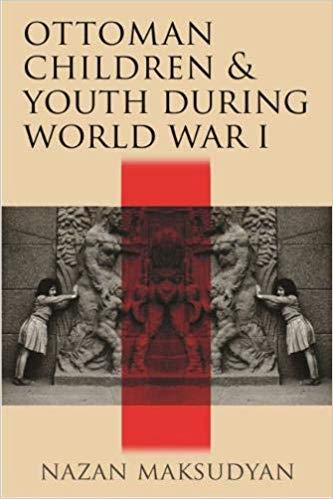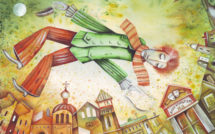

Nazan Maksudyan’s recent book Ottoman Children and Youth during World War I follows her previous book on Ottoman orphan and destitute children in the late nineteenth and early twentieth centuries[1] into the last decades of the Ottoman Empire by examining the children and youth during the First World War. Her multi-faceted approach on the experiences of children during the war contributes immensely to the recent historiography of the First World War that focuses on its social and economic dimensions. It complements the soldier narratives and gender histories, as well as the literature on the war front and the home front suffering, as the military and civilian realms were blurred in the Great War. Maksudyan’s book is a major addition to these social histories of First World War and the everyday experiences of civilians.
Her book provides a very concise history of two Ottoman institutions that targeted the children during the First World War: state orphanages and an apprentice exchange program with wartime ally Germany. Maksudyan brings new insights into the motives of the Empire in setting up these institutions and modifying them along the way for its interests. She also analyzes the militarization of children by the state and their own communities. However, in her narrative, children are not just objects of control, but active participants of history with their own agency.
The experiences of Ottoman children and youth, an understudied segment of Ottoman society, open new venues of research that highlight this agency to deal with the enormous challenges of wartime. Maksudyan shows how these “children were legitimate partakers of, actors in, and witnesses to Ottoman political action and experience in the war,” and how they took part in “every facet of total war” as “soldiers, wage earners, farmers and artisans” (11). She examines these children’s suffering under authority as well as their coping mechanisms, thereby putting them at the center of her historical narrative of war.
The Ottoman state orphanage (darüleytam) network, encompassing Istanbul and the provinces, was established only during the First World War despite earlier efforts. Even though these orphanages were designed to accommodate the Muslim children of Ottoman martyrs (evlad-ı şüheda), of men who died at war, and the children of Ottoman Muslim refugees (muhacirs), Maksudyan highlights the Ottoman state policy of incorporating non-Muslim children into the system as a way to “assimilate” them into the Ottoman Muslim identity. She also emphasizes the significance of nationalization of foreign property and confiscation of non-Muslim property to provide for these institutions. Within the network, there are fewer orphanages for girls, as female adoption or incorporation of girls into households as domestic labor or wives were other options. Thus, many darüleytams performed virginity tests for the orphan girls to enter. State orphanages were mostly overcrowded, and hunger and disease were constant issues of struggle for the orphan children, leading them to escape and perform other rebellious acts. Although vocational training was one of the pillars of the network to generate income to be self-sufficient, few of these orphanages had actual resources, which limited the educational opportunities of the children. Towards the end of the war, the state orphanage network was severely downsized, as most provincial orphanages were shut down. Only a small number of the orphan children in the provinces were sent to Istanbul. These children would find it difficult to stay in already the few overcrowded and overstretched orphanages that stayed open after the Allied victory, as many of the foreign and non-Muslim buildings that were confiscated were returned.
A few of Ottoman orphan boys were also displaced to Germany to be part of the apprenticeship system during the war. This exchange was a way for the Ottoman state to decrease the financial burden of the darüleytam children. These children took part in crafts, farming, and mining, thus providing for the German wartime economy. Although the numbers of apprentices sent to Germany did not exceed several hundred (though the Ottoman officials anticipated to send as many as five to ten thousand), their experience of displacement is an important case study. By utilizing personal narratives, Ottoman, and German state records, Maksudyan analyzes this unique project of long-distance displacement. The children were sent to Germany via military freight train rather than the luxurious passenger train the Balkanzug, and the journey lasted ten days from Istanbul and thirty days from the provinces. They did not have warm clothes and shoes appropriate for the German winter, nor did they have any language training to be able to communicate. The insufficient clothing of these apprentices as well as their demands for helal food became serious issues of diplomatic contention, as German host families complained about the costs they had to endure. The boys were also not well-trained for the trades they were matched up with, and they could not earn any pocket money or salary as these were unpaid apprenticeships. Still, they kept asking for betterment of their conditions, or ran away as a way of expressing disenchantment and seeking empowerment. By the end of war, they were repatriated, crowding Istanbul orphanages once more, and some of the older boys were employed in state factories. Few of them managed to stay in Germany as they utilized their own means and their masters provided jobs for them.
Many Ottoman urban children were also militarized either by the Ottoman state or through their communal organizations during the war. As the religious, ethnic, and national identities were heightened, even children participated in the war making effort through scouting activities. The Ottoman government established Ottoman Strength Associations to incorporate military exercise and drills to Muslim religious schools and state schools for premilitary age children. In 1916, Youth Leagues were established, modeled after the German ones, to provide a more efficient organization and promote war effort through paramilitary training to every Muslim child in both urban and rural areas. During the Allied occupation (1918-22), non-Muslim children also participated in scouting activities of their communal organizations. As Maksudyan shows, wartime conditions even affected the everyday lives of kids and “playing war” became an activity both for Muslim and non-Muslim children. She further emphasizes how the Ottoman wartime propaganda and mobilization focused on the Muslim and ethnic Turkish identity, and how the non-Muslim children became a target population to assimilate.
Maksudyan’s most powerful section highlighting children’s agency investigates the unique experiences of the Armenian orphan children during the war, providing an important dialogue with the Armenian genocide literature. She discusses “the private acts of seizing, adopting or selling children” as well as the Ottoman state’s efforts to incorporate them into Muslim households or state orphanages (111). She also points out to the Armenian and international efforts to “rescue” them after the war. However, her chapter’s emphasis on the survival techniques of many children and the agency they exercised in order to survive, thrive, and negotiate better outcomes for themselves is a testament to the crucial role children have in shaping our understanding of the Great War. Armenian children “used their intelligence, talents, charms, and beauty” (106) to survive. They played, traded, and took part in adventures; they stayed in and out of the state orphanages and Muslim households. It is true that many of them were forcefully incorporated into these households, but they also voluntarily sought adoption or marriage as a method of survival. Furthermore, they constantly resisted, escaped, and sought ways to join with their extended families or be part of the Armenian or the international orphanages, thus actually becoming “self-rescuers.” Carbinger children (an Armenian term for the talented) created better opportunities for themselves and their friends. During these multi-faceted journeys of the Armenian orphan children, even though the trauma of loss and suffering was one dimension of their story, friendship, solidarity and having fun was the other dimension that was necessary to survive and be resilient.
Maksudyan’s most timely book utilizes a unique combination of Ottoman and German state archives, as well as personal narratives, diaries, oral histories, contemporary press accounts, schoolbooks, papers of youth organizations, and reports of international humanitarian agencies and personnel. As she points out, this book is a history of children that does not encompass all groups, but the ones most visible to show agency in the archival sources in terms of how they shaped and were shaped by the war effort. Her narrative emphasizes the experiences of orphans except in the third chapter, and she favors urban children over the rural and inescapably male over female. On the other hand, the amount of material she presents and the voice she gives to these children and youth, both Muslim and non-Muslim, and male as well as female, make her contribution to the social histories of First World War indispensable. These Ottoman children were part of the generation who lost their childhood to the Great War, but who would become the first adult generation of postwar nation-states, and their history and agency tremendously enhances our understanding of this “total war” that affected all aspects of Ottoman social life in the last years of the Empire.
Pınar Odabaşı Taşcı is a PhD Candidate in the History Department at University of Akron. Her dissertation on early twentieth-century Ottoman Edirne has been funded by Fulbright Hays Doctoral Dissertation Research Abroad Fellowship, Institute of Turkish Studies’ Dissertation Writing Grant and University of Akron’s R. W. Little Graduate Fellowship.
Ottoman Children and Youth during World War I
By Nazan Maksudyan
Publisher: Syracuse University Press
Hardcover / 210 pages / 2019
ISBN: 9780815636274
[1] Nazan Maksudyan, Orphans and Destitute Children in the Late Ottoman Empire. Syracuse University Press, 2014.
Published on August 4, 2020




